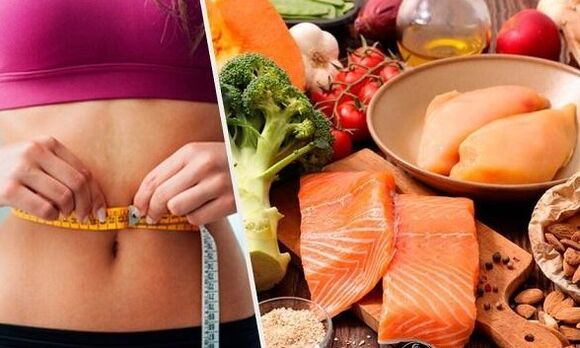A ketogenic diet (ket) is a very low carbon diet that helps burn fat. It has many benefits for weight loss and improved health, but also some side effects.

- The pluses of a keto diet
- Which is forbidden on a keto diet
- How to find out what you are in Ketoss?
- Side effects of diet and how to avoid them
The ketogenic diet is similar to other strict diets with low carbohydrate content such as ATKINS or LCHF diet. These diets often end with ketogenic more or less accidental. The main difference between the strict LCHF and the keto diet is that the protein is limited to the latter.
With ketosis, the body produces small fuel molecules called "ketones". This is an alternative fuel for the body.
Ketones are produced if you eat very little carbohydrates (which are quickly divided into blood sugar) and a moderate amount of protein (excess protein can also turn into blood sugar).
How to lose weight in baby food?
Ketones are formed in the liver of fat. Then they are used as fuel throughout the body, including the brain. The brain is an organ that consumes a lot of energy every day and cannot work directly on fat. It can only work on glucose. SSor ketones.
On a ketogenic diet, your whole body goes away from the delivery of fuel with carbohydrates and works almost completely on fat. The level of insulin becomes very low, and the burning of fat increases sharply. The body is easy to access your own fat stores to burn them.
The pluses of a keto diet
The benefits of a ketogenic diet are similar to any strict diet with a low car. However, the effect can be even higher as the protein is limited. Such a diet increases the level of ketones and reduces the level of insulin.

- The burning of fat in the keto diet increases significantly because the insulin falls. This creates the ideal conditions under which weight loss without hunger can occur.
- About 20 scientific studies show that, compared to other diets, low-carbohydrates and keto, diet lead to more effective weight loss.
- Ketosis leads to a steady intake of fuel (ketones) in the brain. And on a ketogenic diet you will avoid major fluctuations in blood sugar. This often leads to increased attention and increased concentration.
- Many people specifically use a keto diet to increase mental results. After a few days (up to a week), the keto adaptation during which a person can experience some difficulties with concentration, headache, irritability, the body and the brain will switch and can easily work on ketones.
- In a state of ketosis, many people experience more energy.
- A ketogenic diet can also greatly increase your physical endurance, giving you constant access to energy from your fat stores.
- The delivery of the body with carbohydrates (glycogen) is enough for only a few hours of intensive training or less. When, as your greasy reserves will give enough energy for long and intense classes.
Which is forbidden on a keto diet
Most importantly, in order to achieve ketosis, you should avoid using carbohydrates, ideally reduce consumption below 20 grams. The less carbohydrates, the more effective.
How to find out what you are in Ketoss?
Ketosis can be measured by testing urine, blood or breathing. But there are clear signs. Symptoms of ketosis: dry mouth, thirst, frequent urination.
Dry mouth and increased thirst. If you drink enough and have enough electrolytes, you can feel dry in your mouth. Try drinking a glass of broth or two a day, plus drink as much water as you need.
Increasing urination is another symptom of ketosis.

Keto-drying of the bodies of ketone, the smell of acetone appears from the mouth, the smell can also be "fruit" or resemble the smell of lacquer fluid. This smell is sometimes felt by sweat, all this will pass briefly and after the ket adaptation has passed.
Other, less specific, but more positive features include:
Hunger Reduction - Many people experience a noticeable reduction in hunger. This can be caused by the body's increased ability to feed on its fat reserves. Many people feel great, eat only once or twice a day, you can do periodic fasting. This saves time and money and also speeds up weight loss.
Increasing energy - in a few days a feeling of fatigue will pass and you will feel an increase in energy and productivity.
How to achieve a sustainable ketosis
- Limit carbohydrates to 20 grams per day.
- Limiting squirrels to a moderate level. You need to stay at a level or below 1 gram of protein per day per kg body weight. This is about 70 grams of protein per day if you weigh 70 pounds.
- There is enough fat to feel full.
- Avoid snacks when not hungry. Unnecessary snacks slow down weight loss and reduce ketosis.
If necessary, you should add periodic fasting, such as 16: 8 - 16 hours of hunger and 8 hours for food consumption. This is very effective in increasing ketones.
Side effects of diet and how to avoid them

At the initial stage of the transition to the keto mode, side effects may occur - this is called keto -grip. Symptoms such as fatigue, nausea, headache, cramps and more occur. What should be done to prevent or relieve these symptoms:
- Drink water with salt and lemon - you should also drink a glass of broth every day.
- Gradually reduces the consumption of carbohydrates - a sharp reduction leads to more strong symptoms
At the initial stage of a ketogenic diet you lose water and therefore the electrolytes. This happens because carbohydrates slow down the water and salt in the body, so when you stop eating carbohydrates, your body loses this water.
When carbohydrates were suddenly removed from the diet, the brain needs time before learning to use ketone bodies for energy instead of sugar. This means that if you sharply reduce carbohydrates, you can get symptoms such as fatigue, nausea and headache. Reduce carbohydrate consumption for a week or more, the body will get used to burning fat and ketones instead of glucose and the transition will happen easier and without symptoms.






























